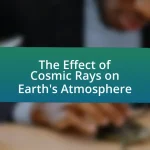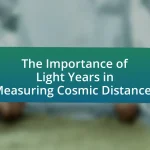Cosmic events, including solar flares, cosmic rays, and asteroid impacts, significantly influence Earth’s climate and environment through various mechanisms. Historical examples, such as the Maunder Minimum and the Chicxulub impact, illustrate the correlation between cosmic phenomena and climate changes. The article explores how solar radiation variations and cosmic ray interactions affect atmospheric conditions, cloud formation, and global temperatures. Additionally, it discusses the importance of understanding these cosmic influences for climate science and outlines strategies for monitoring and mitigating their effects on Earth’s systems.
How do cosmic events impact Earth’s climate and environment?
Cosmic events impact Earth’s climate and environment primarily through mechanisms such as solar radiation variations, cosmic ray influx, and asteroid impacts. Solar flares and coronal mass ejections can lead to increased radiation levels, affecting atmospheric chemistry and potentially altering climate patterns. For instance, the Maunder Minimum, a period of reduced solar activity from 1645 to 1715, coincided with the Little Ice Age, demonstrating a link between solar output and climate cooling. Additionally, cosmic rays, which are high-energy particles from space, can influence cloud formation and, consequently, climate by affecting the ionization of the atmosphere. Furthermore, asteroid impacts can cause significant environmental changes, such as the mass extinction event 66 million years ago, which drastically altered the climate and ecosystems on Earth. These examples illustrate the profound effects cosmic events can have on Earth’s climate and environment.
What types of cosmic events influence Earth’s climate?
Cosmic events that influence Earth’s climate include solar flares, volcanic eruptions on other celestial bodies, and asteroid impacts. Solar flares release large amounts of energy and can affect Earth’s magnetic field, leading to changes in atmospheric conditions. Historical data shows that significant solar activity correlates with climate variations, such as the Little Ice Age, which was influenced by reduced solar output. Volcanic eruptions on other planets, like Mars, can provide insights into climate change mechanisms, while asteroid impacts can cause dramatic shifts in climate by releasing dust and gases that block sunlight, as evidenced by the asteroid impact that contributed to the mass extinction event 66 million years ago.
How do solar flares affect atmospheric conditions?
Solar flares significantly affect atmospheric conditions by releasing bursts of electromagnetic radiation and charged particles that can disrupt the Earth’s ionosphere. This disruption can lead to increased ionization, which affects radio communications and GPS signals. For instance, during intense solar flare events, such as the X-class flares observed in 2003, there were notable disruptions in high-frequency radio communications and satellite operations, demonstrating the direct impact of solar activity on atmospheric conditions.
What role do meteor showers play in environmental changes?
Meteor showers contribute to environmental changes primarily through the deposition of extraterrestrial materials, which can influence atmospheric chemistry and surface conditions. When meteoroids enter Earth’s atmosphere, they burn up and release various elements, such as iron and magnesium, which can affect soil composition and nutrient availability. For instance, studies have shown that the impact of meteor showers can lead to increased levels of certain minerals in the soil, enhancing fertility in some regions. Additionally, the atmospheric entry of meteoroids can produce transient phenomena, such as increased ionization in the upper atmosphere, which may influence weather patterns and climate dynamics.
Why is understanding cosmic events important for climate science?
Understanding cosmic events is important for climate science because these events can significantly influence Earth’s climate systems. For instance, solar flares and cosmic rays can affect atmospheric conditions and contribute to climate variability. Research has shown that increased solar activity correlates with changes in temperature and weather patterns on Earth, as evidenced by studies linking solar cycles to historical climate data. Additionally, cosmic events like supernovae can impact Earth’s atmosphere by introducing high-energy particles, which may influence cloud formation and precipitation patterns. Thus, comprehending these cosmic phenomena is essential for accurately modeling and predicting climate changes.
How can cosmic events provide insights into climate patterns?
Cosmic events can provide insights into climate patterns by influencing solar radiation and atmospheric conditions on Earth. For example, solar flares and cosmic rays can affect cloud formation and climate variability. Research indicates that increased cosmic ray activity correlates with lower temperatures on Earth, as seen during the Little Ice Age, when reduced solar activity coincided with cooler climate conditions. Additionally, volcanic eruptions, which are cosmic events, release aerosols that can lead to temporary cooling by reflecting sunlight away from the Earth. These connections demonstrate how cosmic phenomena can directly impact climate dynamics and patterns.
What historical examples illustrate the impact of cosmic events on climate?
Historical examples illustrating the impact of cosmic events on climate include the Toba supereruption around 74,000 years ago, which is believed to have caused a volcanic winter, leading to a significant drop in global temperatures and a reduction in human populations. Another example is the impact of the Chicxulub asteroid approximately 66 million years ago, which contributed to the mass extinction of the dinosaurs and resulted in drastic climate changes due to the release of dust and aerosols into the atmosphere, blocking sunlight and cooling the Earth. Additionally, the Maunder Minimum, a period from 1645 to 1715, coincided with a decrease in solar activity, which correlated with the Little Ice Age, causing colder temperatures in Europe and North America. These events demonstrate the profound influence cosmic occurrences can have on Earth’s climate systems.

What mechanisms link cosmic events to climate changes on Earth?
Cosmic events influence climate changes on Earth primarily through mechanisms such as solar radiation variations, cosmic ray interactions, and volcanic eruptions triggered by celestial impacts. Solar radiation variations, particularly during solar cycles, affect Earth’s temperature and weather patterns; for instance, the Maunder Minimum (1645-1715) coincided with a period of cooler temperatures known as the Little Ice Age. Cosmic rays, which are high-energy particles from space, can influence cloud formation and, consequently, climate by affecting atmospheric ionization levels. Additionally, large asteroid or comet impacts can lead to significant volcanic activity, releasing aerosols and greenhouse gases that alter the climate, as evidenced by the Chicxulub impact that contributed to the mass extinction event 66 million years ago. These mechanisms demonstrate the interconnectedness of cosmic phenomena and terrestrial climate dynamics.
How do cosmic rays influence cloud formation?
Cosmic rays influence cloud formation by ionizing particles in the atmosphere, which can enhance the nucleation of cloud droplets. This process occurs when high-energy particles from space collide with atmospheric molecules, creating ions that serve as nuclei for water vapor to condense upon. Research indicates that increased cosmic ray activity correlates with higher cloud cover, as demonstrated in a study published in the journal “Atmospheric Chemistry and Physics” by authors including Svensmark and Friis-Christensen, which found a link between cosmic ray intensity and cloud formation patterns over several decades.
What is the relationship between cosmic rays and climate variability?
Cosmic rays have a complex relationship with climate variability, primarily influencing cloud formation and, consequently, climate patterns. Research indicates that increased cosmic ray activity can enhance the production of aerosols in the atmosphere, which serve as cloud condensation nuclei. This process can lead to changes in cloud cover and albedo, potentially affecting global temperatures. A study by Svensmark and Friis-Christensen (1997) published in the Journal of Atmospheric and Solar-Terrestrial Physics found a correlation between cosmic ray flux and global temperature variations over the 20th century, suggesting that cosmic rays may play a role in climate variability.
How do changes in cloud cover affect global temperatures?
Changes in cloud cover significantly affect global temperatures by altering the Earth’s energy balance. Increased cloud cover generally leads to a cooling effect because clouds reflect sunlight back into space, reducing the amount of solar radiation that reaches the Earth’s surface. For instance, studies have shown that low-level clouds can reflect up to 90% of incoming solar radiation, which can lower surface temperatures. Conversely, decreased cloud cover allows more solar radiation to penetrate, resulting in warming. Research indicates that a 1% decrease in cloud cover can lead to an increase in global temperatures by approximately 0.5 degrees Celsius. Thus, variations in cloud cover play a crucial role in regulating the Earth’s climate system.
What is the effect of solar cycles on Earth’s climate?
Solar cycles have a measurable effect on Earth’s climate, primarily through variations in solar radiation. These cycles, which last approximately 11 years, influence the amount of solar energy reaching Earth, affecting atmospheric temperatures and weather patterns. For instance, during periods of high solar activity, known as solar maximum, increased solar radiation can lead to slight warming, while solar minimum periods can correlate with cooler temperatures. Historical data, such as the Maunder Minimum (1645-1715), demonstrates that reduced solar activity can coincide with significant climate anomalies, including the Little Ice Age, indicating a direct relationship between solar cycles and climate variations.
How do variations in solar radiation impact weather patterns?
Variations in solar radiation significantly impact weather patterns by influencing temperature, atmospheric circulation, and precipitation. Increased solar radiation leads to higher surface temperatures, which can enhance evaporation rates and alter humidity levels, subsequently affecting cloud formation and precipitation patterns. For instance, during periods of high solar activity, such as solar maximum, regions may experience warmer temperatures and altered storm tracks, leading to changes in rainfall distribution. Historical data shows that fluctuations in solar output correlate with climate changes, such as the Little Ice Age, which was associated with reduced solar activity. This evidence underscores the critical role solar radiation plays in shaping weather systems and climate dynamics.
What evidence supports the connection between solar cycles and climate change?
Evidence supporting the connection between solar cycles and climate change includes variations in solar irradiance and historical climate data. Research indicates that solar cycles, which last approximately 11 years, influence the amount of solar energy reaching Earth, affecting global temperatures. For instance, studies have shown that periods of high solar activity correlate with warmer climate phases, such as the Medieval Warm Period, while low solar activity aligns with cooler periods like the Little Ice Age. Additionally, satellite measurements since the late 20th century have documented changes in solar output, revealing a direct relationship between solar irradiance and surface temperature fluctuations. These findings are supported by data from the National Oceanic and Atmospheric Administration, which highlights the role of solar cycles in modulating Earth’s climate over centuries.

How can we mitigate the effects of cosmic events on our environment?
To mitigate the effects of cosmic events on our environment, we can develop advanced monitoring systems and implement protective technologies. Monitoring systems, such as satellite networks, can detect solar flares and cosmic radiation, allowing for timely warnings and preparedness measures. For instance, the Solar and Heliospheric Observatory (SOHO) provides real-time data on solar activity, which helps in forecasting potential impacts on Earth’s magnetic field and atmosphere. Additionally, protective technologies like electromagnetic shielding can be designed for critical infrastructure, reducing vulnerability to solar storms. Historical data shows that the 1989 geomagnetic storm caused widespread power outages in Quebec, highlighting the need for proactive measures to safeguard against similar future events.
What strategies can be employed to prepare for cosmic events?
To prepare for cosmic events, individuals and organizations can implement strategies such as monitoring celestial activity, developing emergency response plans, and investing in research and technology. Monitoring celestial activity involves using telescopes and satellites to track asteroids, comets, and solar flares, which can provide early warnings of potential threats. For instance, NASA’s Near-Earth Object Observations program actively tracks and catalogs near-Earth objects to assess their risk to Earth. Developing emergency response plans ensures that communities are ready to act in the event of a cosmic event, such as a solar storm that could disrupt power grids. Additionally, investing in research and technology enhances our understanding of cosmic phenomena and improves our ability to mitigate their impacts, as demonstrated by advancements in space weather forecasting. These strategies collectively enhance preparedness for cosmic events and their potential effects on Earth’s climate and environment.
How can technology help in monitoring cosmic events?
Technology aids in monitoring cosmic events through advanced telescopes, satellite systems, and data analysis software. These tools enable astronomers to observe celestial phenomena such as supernovae, gamma-ray bursts, and solar flares in real-time. For instance, the use of the Hubble Space Telescope has allowed for detailed imaging and analysis of distant galaxies and cosmic explosions, providing insights into their impact on cosmic radiation levels. Additionally, satellites like the Solar Dynamics Observatory continuously monitor solar activity, which is crucial for understanding how solar events influence Earth’s climate and environment. The integration of artificial intelligence in data processing further enhances the ability to predict and analyze these events, making monitoring more efficient and accurate.
What role do international collaborations play in addressing cosmic impacts?
International collaborations play a crucial role in addressing cosmic impacts by facilitating the sharing of data, resources, and expertise among countries. These partnerships enable the development of comprehensive monitoring systems, such as the European Space Agency’s Space Debris Office, which tracks near-Earth objects and assesses potential threats. Collaborative efforts, like the International Asteroid Warning Network, enhance global preparedness for asteroid impacts by coordinating research and response strategies. Such initiatives demonstrate that collective action is essential for effectively mitigating risks associated with cosmic events, as evidenced by the successful detection and deflection tests conducted by multiple space agencies.
What are the best practices for communities to adapt to cosmic influences?
Communities can adapt to cosmic influences by implementing early warning systems, enhancing infrastructure resilience, and promoting public education on cosmic events. Early warning systems, such as satellite monitoring and data analysis, allow communities to anticipate and respond to cosmic phenomena like solar flares or meteor showers, reducing potential damage. Infrastructure resilience can be achieved through building codes that account for cosmic events, ensuring structures can withstand extreme weather changes linked to cosmic influences. Public education initiatives inform residents about the effects of cosmic events on climate and environment, fostering a culture of preparedness. These practices are supported by research indicating that proactive measures significantly mitigate risks associated with cosmic influences, as seen in regions that have successfully integrated such strategies into their disaster management plans.
How can local governments implement effective response plans?
Local governments can implement effective response plans by establishing clear communication channels, conducting regular training exercises, and collaborating with scientific organizations to understand cosmic events’ impacts on climate. Clear communication ensures that all stakeholders, including emergency services and the public, are informed and prepared. Regular training exercises help local governments practice their response strategies, improving coordination and efficiency during actual events. Collaborating with scientific organizations provides access to data and expertise, enabling local governments to develop informed strategies that address the specific challenges posed by cosmic events, such as increased radiation or climate anomalies.
What educational resources are available for public awareness on cosmic events?
Educational resources for public awareness on cosmic events include websites, documentaries, and educational programs. NASA’s website offers extensive information on cosmic events, including solar flares and meteor showers, with data and educational materials accessible to the public. The European Space Agency also provides resources that explain cosmic phenomena and their potential impacts on Earth. Additionally, documentaries such as “The Universe” series on various streaming platforms present cosmic events in an engaging format. Educational programs in schools often incorporate materials from organizations like the American Astronomical Society, which promotes public understanding of astronomy and cosmic events. These resources collectively enhance public knowledge and awareness of how cosmic events can influence Earth’s climate and environment.



